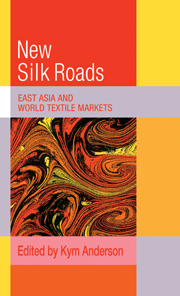Book contents
- Frontmatter
- Contents
- List of figures
- List of tables
- Contributors to this volume
- Preface
- Abbreviations and acronyms
- Symbols
- Introduction and summary
- I FIBRES, TEXTILES AND ECONOMIC DEVELOPMENT
- II DEMAND FOR TEXTILE EXPORTS FROM NEWLY INDUSTRIALIZING ASIA
- III CONCLUSIONS
- Appendix: Data on world production, consumption and trade in textiles, clothing and fibres
- Bibliography
- Index
- Frontmatter
- Contents
- List of figures
- List of tables
- Contributors to this volume
- Preface
- Abbreviations and acronyms
- Symbols
- Introduction and summary
- I FIBRES, TEXTILES AND ECONOMIC DEVELOPMENT
- II DEMAND FOR TEXTILE EXPORTS FROM NEWLY INDUSTRIALIZING ASIA
- III CONCLUSIONS
- Appendix: Data on world production, consumption and trade in textiles, clothing and fibres
- Bibliography
- Index
Summary
For centuries East Asia has been home to an important part of the world's textile industry. Its role for most of that period has been as a supplier of natural fibres which were exported to Europe via the socalled Silk Road. During recent decades, however, East Asia's production and exports of textile products have expanded dramatically, transforming the region into a major net importer of natural fibres. Even by the first half of the 1960s its net imports of natural fibres represented one-sixth of world fibre trade, compared with Western Europe's two-fifths. But, by the first half of the 1980s, East Asia's share had doubled while Western Europe's had almost halved.
This dramatic redirection of world fibre trade was driven initially by the success of Japan and then Northeast Asia's newly industrialized economies in developing export-oriented textile and clothing industries and penetrating the markets of more advanced industrial economies. Then in the 1980s China joined its neighbours as a rapidly expanding producer and exporter of textiles and clothing. At the same time, however, China also began to expand its domestic production of fibres. This raised questions in the minds of traditional fibre exporters such as Australian wool producers and US cotton growers as to the net impact China would have on world fibre markets. As a result, the Australian Wool Research and Development Fund in 1987 commissioned a study to address those questions. The Australia–Japan Research Centre (AJRC) of the Australian National University, Canberra, coordinated the three-year project and provided additional funding to ensure its satisfactory completion.
- Type
- Chapter
- Information
- The New Silk RoadsEast Asia and World Textile Markets, pp. xv - xviPublisher: Cambridge University PressPrint publication year: 1992

